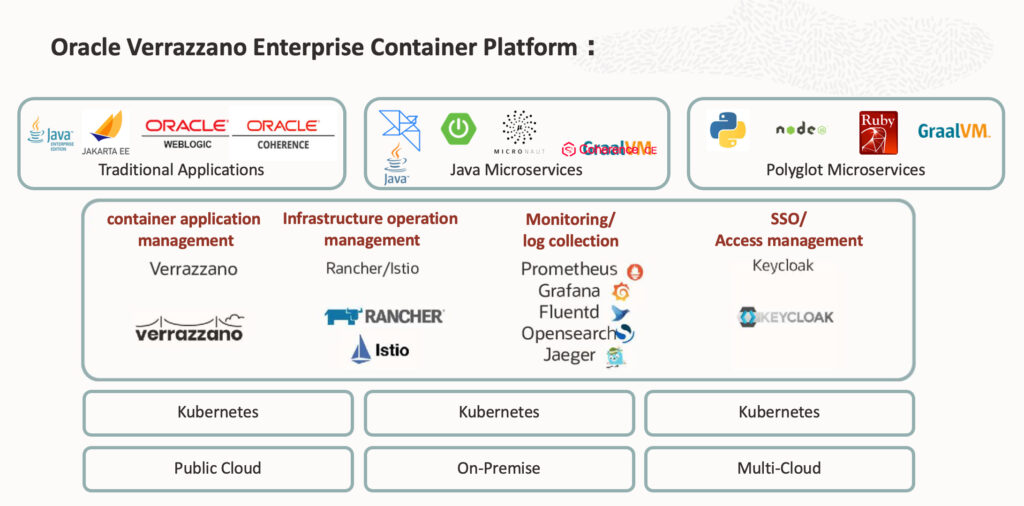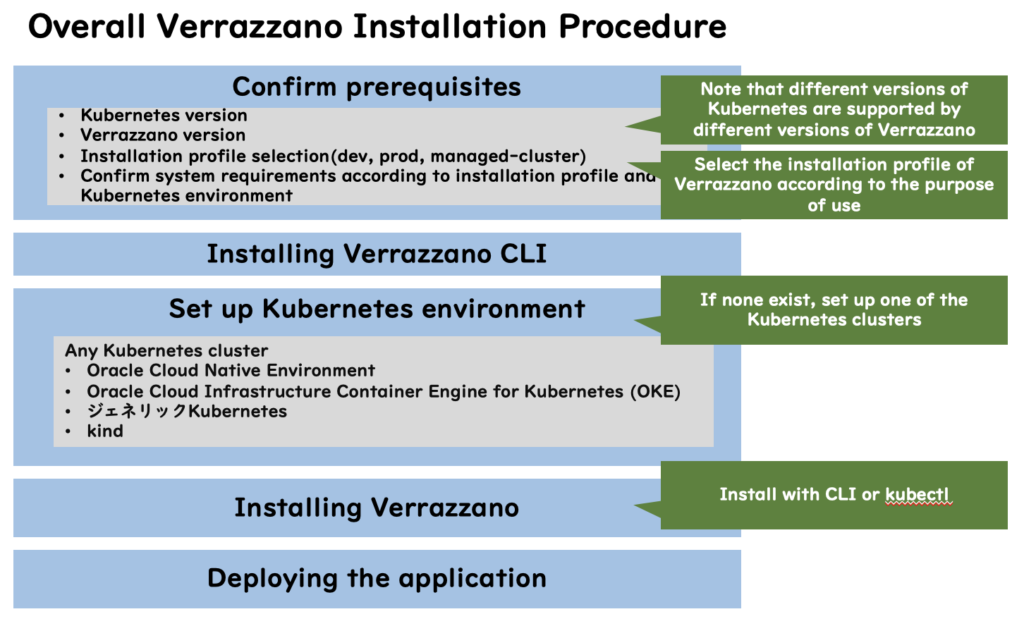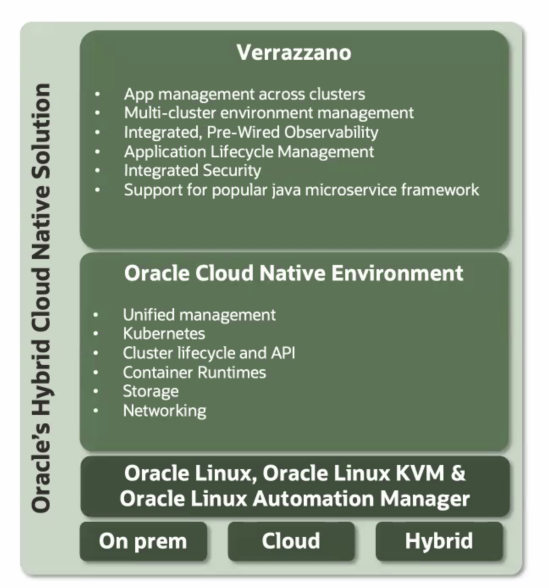Do you know about Oracle Verrazzano? Verrazzano is a container platform that allows you to comprehensively manage the lifecycle of a multi-Kubernetes environment.
It is difficult to understand this explanation written in the manual. Let’s explain it a little more clearly.
Let’s say you have a containerized application or a traditional application. It may be running in the public cloud or on-premises. In such an environment, it is a platform that promotes the containerization of traditional applications and integrates the management and deployment of Kubernetes in multiple environments such as the cloud and on-premises.
This time, we will briefly introduce this Oracle Verrazzano and explain how to install it.
By the way, if you search for Verrazzano, you will see results such as race horses at the top. However, it is believed that the word originated from Giovanni da Verrazzano, a 16th-century Italian ocean explorer from Florence.
What is Oracle Verrazzano?
For an overview of Verrazzano, see our Oracle Verrazzano introduction page and the following materials published by Oracle. Here’s a quick explanation.
- * [Verrazzano Enterprise Container Platform]
- * [Oracle Verrazzano Enterprise Container Platform Data Sheet]
The official name of Oracle Verrazzano is Verrazzano Enterprise Container Platform, which is provided as open source. v1.0 was released in August 2021, and the latest version in August 2023 is v1.6. It is free to use, but we also offer paid commercial support called Oracle Verrazzano Premier.
The following diagram is an overview of Oracle Verrazzano. As you can see from this figure, we have combined a lot of open source components to achieve infrastructure operation management, monitoring functions, and security functions (SSO/access management).

Verrazzano is described in the official documentation as follows:
Verrazzano is an end-to-end enterprise container platform for deploying cloud native and traditional applications in multicloud environments. It is made up of a curated set of open source components – many that you may already use and trust, and some that were written specifically to pull together all of the pieces that make Verrazzano a cohesive and easy to use platform.
Similar commercial platforms include Red Hat OpenShift and VMware Tanzu.
It is difficult to understand Verrazzano even after this explanation, but to summarize the benefits from the perspective of “what you get out of it,” they are as follows:
- Allows multiple Kubernetes clusters, including on-premises, to be managed through a single interface
- The features that Kubernetes lacks, such as security and monitoring, are complemented by a combination of proven open source components. In other words, it improves user convenience by playing a Linux distribution role.
- Converting a traditional application to a cloud-native modern application can take a lot of effort, but with Verrazzano, it can be migrated in a shorter time. In particular, WebLogic, Coherence, and Helidon (*) developed by Oracle provide more user-friendly features.
* Heridon is a Java application framework developed by Oracle that is suitable for the development of MicroProfile-compliant microservices.
Verrazzano installation procedure
The following diagram shows the Verrazzano installation procedure. The key points are “Set up Kubernetes environment” and “Installing Verrazzano”.

Depending on the Kubernetes environment you use, the effort required to build and the hardware resources to prepare will vary greatly. In addition, the installation of Verrazzano is the main task, and Verrazzano is set up in the container environment of Kubernetes. Once that’s done, you’ll be able to deploy the container application.
Note the procedure in the official manual
The quick start of the official manual assumes that a Kubernetes cluster is being built. Therefore, we will skip the method of building a Kubernetes cluster and introduce the following procedure as a method of installing Verrazzano.
- Install Verrazzano CLI
- Create Verrazzano as a custom resource in a Kubernetes cluster
- Deploy the container application to Kubernetes
However, when there is no Kubernetes cluster, it must be built beforehand.
Kubernetes cluster options
As options to build a Kubernetes cluster, the Verrazzano manual introduces the following four types:
- Oracle Cloud Infrastructure Container Engine for Kubernetes (OKE)
- Oracle Cloud Native Environment
- Generic Kubernetes
- kind
Within these, the easiest option is to use Oracle Cloud Infrastructure’s OKE. The build procedures are also introduced in various documents.
Oracle Cloud Native Environment is an open software suite for on-premises Kubernetes-centric container environments. In other words, it is a software set that achieves multifunctionality such as managed Kubernetes services on the on-premises server. It can be said that it is a Kubernetes distribution provided by Oracle.
Generic Kubernetes is so-called basic Kubernetes.
kind is a tool that uses Docker containers as worker nodes to configure Kubernetes clusters locally. You can build multi-node clusters that are not possible with a single node, such as Minikube.
So this time, we will build a Kubernetes cluster using the relatively simple kind, that can only be achieved on-premises.
Architecture diagram when configured with Oracle Cloud Native Environment and Verrazzano

Prerequisites for installation
Check the prerequisites according to the purpose of use and the environment in which it is used.
Determine installation profile
Verrazzano offers three installation profiles depending on the configuration used. In addition, the system requirements describe the necessary hardware requirements for each. Ensure that the required resources are met, depending on the purpose of use.
- prod:Full installation configuration for production environment
- dev:Configuration for development and evaluation
- managed-cluster:Installation for a managed cluster in a multi-cluster environment. In the diagram below, it is used when installing on a Managed Cluster

Determine Verrazzano and Kubernetes version
Each version of Verrazzano supports a different version of Kubernetes. Therefore, check the version of Kubernetes supported by Verrazzano in Supported software versions. The support status for v1.5 and v1.6 is shown in the table below.
| Verrazzano | Kubernetes Versions |
|---|---|
| 1.6 | 1.24, 1.25, 1.26 |
| 1.5 | 1.21, 1.22, 1.23, 1.24 |
As you will know if you are familiar with Kubernetes, the software related to Kubernetes is updated frequently. Please be sure to check the latest information. Also, if you have a good knowledge of Kubernetes and can resolve it on your own without following the manual, we recommend that you keep each up to date to the extent supported.
The Verrazzano manual uses Kubernetes version 1.21 for kind. This time it is for testing purposes, so use Verrazzano 1.5 and Kubernetes 1.21, the same as in the manual.
Conclusion
Since we could not proceed with the actual installation this time, we will explain how to install it in the next article.